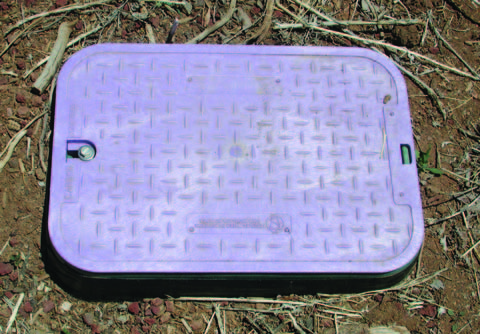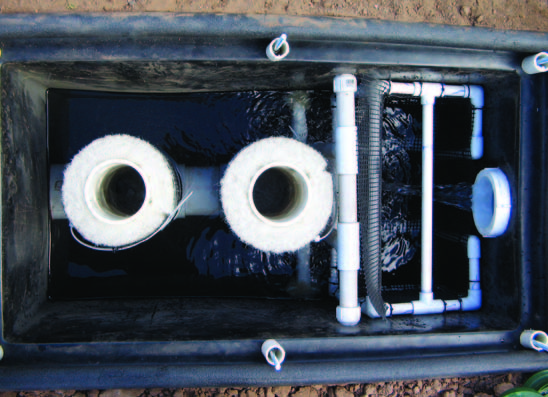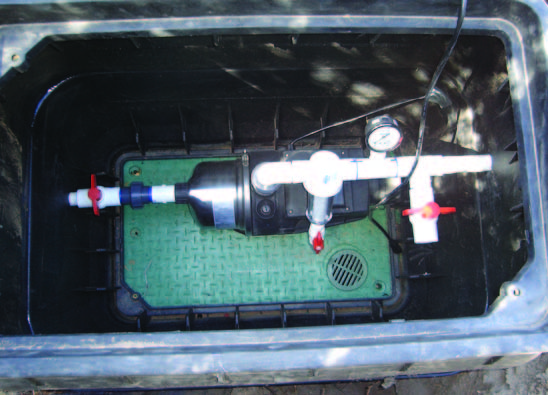The PermaDesign Weblog, with Nate Downey and Melissa McDonald!
Roof-Reliant Landscaping™ Step 19: Maintenance

Above: This purple valve box cover indicates the water in this system is nonpotable.
After the design, installation and successful use of a rainwater harvesting system, the roofreliant landscaper’s work is not over. In order to keep a cistern system functioning efficiently, routine inspection and maintenance are required on a regular basis.
It is important to note here that good documentation of the system is a tremendous aid to ongoing maintenance—whether that maintenance is to be done by the system’s owner or performed by a hired professional. Make sure your roof-reliant landscaping file or notebook is filled with design renderings, calculations, schematic drawings, and photographs and/or illustrations of pipe slopes and other important below-ground components. You should also have “as built” documentation that shows how every part of the system fits together in the landscape. One of the best ways to document the system is to give every component a name, number and insatllation date, and have photographs taken to accompany a written narrative that describes each piece of the system and how it fits together as a whole. Your file should also contain the manufacturers’ information and warranties for all system components.
Some professional rainwater harvesting system installers recommend a video-recorded walkthrough and explanation of the entire system just after installation has been completed. This recorded walkthrough identifies all of the system components and their operation, including such details as switch and valve settings. The video documentation also shows how some of the basic system maintenance is performed, such as how filters are cleaned and how to drain pipes and hoses in preparation for winter season shutdown, or conversely, how to start up the system in the spring.
Also, when it comes to hiring an outside contractor to maintain your system, please note that (at the time of this writing) there are no licensing or inspection regulations established by the State of New Mexico, so make sure your contractor has credible references.
Basic System Maintenance
With all rainwater harvesting systems, the best maintenance is preventative maintenance. Many problems can be avoided by proper planning and careful installation.
But whether your system is simple or quite complicated and whether your cistern is aboveground or below-ground, basic maintenance procedures are required to ensure that your system functions properly.
Every system will have specific attributes that may present some unique maintenance issues. However, for the purposes of this manual, we will look at the four areas of a roof-reliant landscaping system (collection, conveyance, storage and distribution) and offer a guide to the basic maintenance issues that arise in each area.

Above: A rainwater prefilter.
Collection
Many problems that occur in rainwater harvesting systems concern the debris that collects in catchment areas, such as flat roofs, canales and gutters. Because these surfaces are flat or only slightly pitched, they naturally collect a variety of debris including leaves, bird droppings and windblown dirt and sand.
Maintenance for collection areas includes thefollowing tasks:
• Conduct an inspection of all catchment surfaces each season. Remove any large debris.
• Clean out clogged canales and/or gutters. Remove all debris such as trapped leaves.
• Clean gutter screens.
• Inspect canales and/or gutters for signs of damage. Repair any leaks or cracks.
Conveyance
Debris is also troublesome for the conveyance system. Your seasonal maintenance checklist
should include these tasks:
• Clean first-flush devices. If a “dead-end pipe” or similar device is used as a first-flush filter, open the cap to drain any existing water and clean out the debris from the bottom of the pipe.
• Empty debris from roof-washers. If necessary, clean the filter with water and a soft bristle brush.
• Empty roof-washers immediately during cold weather to prevent the water from freezing and potentially damaging the unit.
• Check downspouts and remove any debris.
• Flush sediment from pipes with a high-pressure wash when necessary.
• Clean all filters. Inspect filters for any signs of wear or damage, and replace as necessary.
Storage
• If necessary, aboveground tanks should be cleaned at least once a year (when the tank is closest to being empty). For small tanks, drain the tank and use a wet/dry vacuum. An enzyme solution (for algae control) can be used to clarify the water.
• Check fittings for damage. (Aboveground tanks and their related hardware are more susceptible to freeze damage. To avoid freeze damage, invest in brass fittings and/or leave valves open during colder months when the system is not in use.)
• Check the cistern vent to make sure it is screened to keep out rodents. Small animals can sometimes get into vents, effectively clogging the system and preventing the vent from doing its job.
• If a substantial amount of sediment has accumulated on the bottom of the tank, remove the sediment.
• Long-term maintenance may include washing and disinfecting the storage tank.
• Check overflow pipes for signs of mice and other pests.

Above: A pumphouse with drain pressure gauge and manifold.
Distribution
• Inspect all distribution lines each season. Look for evidence of cracks and leaks. Repair or replace any damaged lines.
• Run water through all distribution piping (underground lines, drip tubing, etc.) to test for sufficient water pressure.
• Inspect all water-delivery devices, such as drip emitters. Clean and/or replace any clogged emitters.
• Clean and maintain filters, including drip filters.
• Make sure all emitters and water-delivery devices are placed properly to water plants’ root zones. Move the emitters to expand the area of water delivery as plants grow.
• Prior to winter shutdown, disconnect the pump housing and drain the pump (provided the pump does not have a heat source). Disconnect and drain the inline pump (if applicable). If you have a complex system, contact a professional to winterize your system.
The goal of any rooftop rainwater harvesting system is maximum efficiency. Your system should be physically inspected throughout the watering season. Watch for any inefficiencies, such as leaks, water pooling, signs of abnormal wear or erosion, missing drip emitters, etc.
Remember, too, that your roof-reliant landscaping system can add to the resale value of your property, so make sure your system documentation is in order and kept up to date. Note any changes made to your system in the master documentation files and/or “as built” files.
03/07/2016 | (0) Comments










Comments